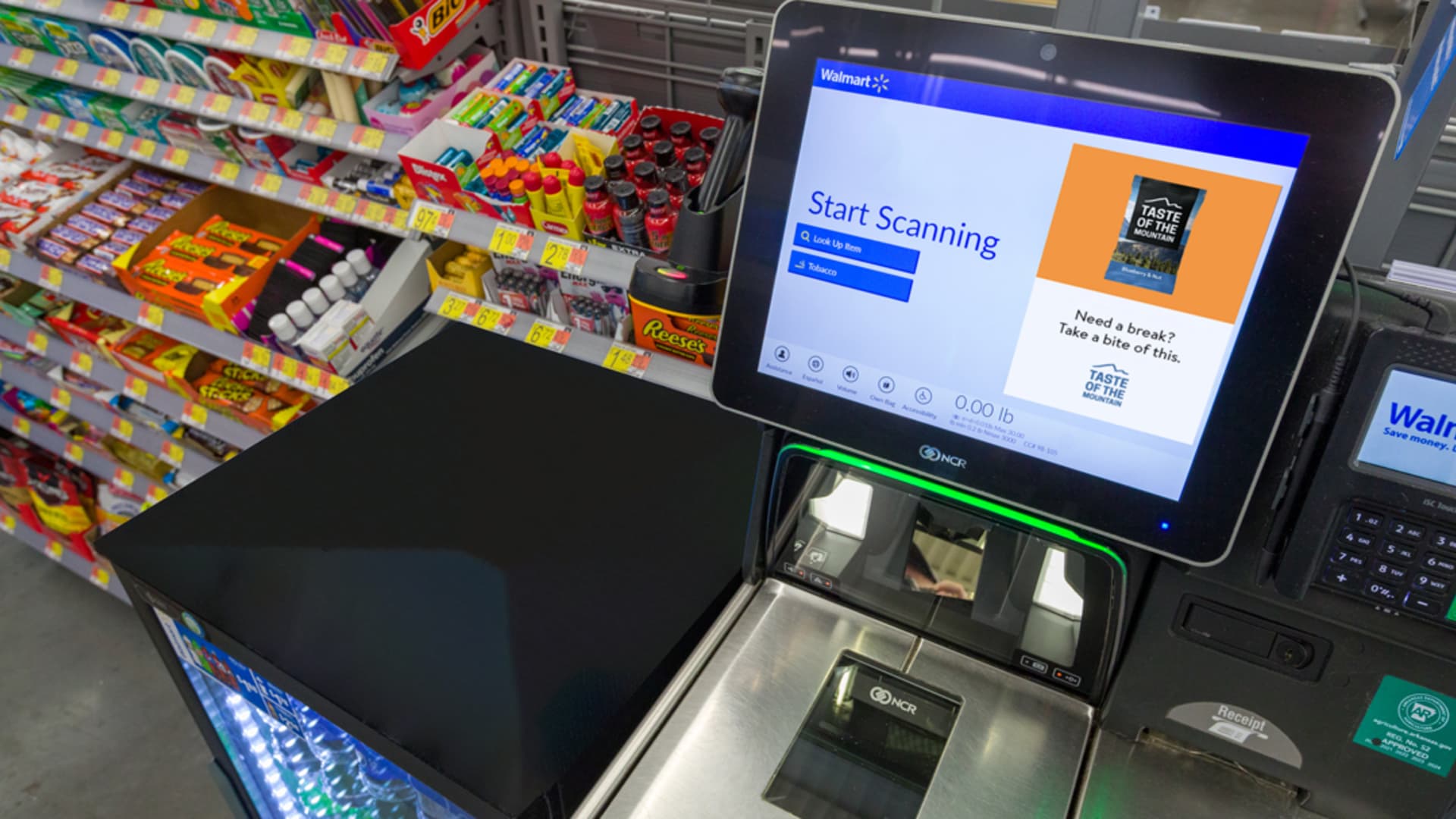One of Walmart‘s latest offerings at its SuperCenters isn’t a hot new toy, snack flavor or sundress. It’s advertising.
Shoppers will soon see more third-party ads on screens in Walmart self-checkout lanes and TV aisles; hear spots over the store’s radio; and be able to sample items at demo stations.
related investing news
Walmart’s push into advertising resembles similar moves by retailers like Kroger, which struck a deal to bring digital smart screens to cooler aisles in hundreds of its stores, and Target, which began testing in-store demos and giveaways, including a recent “Barbie” branded event with Mattel that took place at about 200 stores.
For Walmart, selling ad space to its wealth of existing partners is another way to capitalize on the company’s huge reach and to expand into higher-margin businesses. The discounter has nearly 4,700 stores across the U.S., with roughly 90% of Americans living within 10 miles of a Walmart store.
In the U.S., about 139 million customers visit Walmart stores and its website or app each week.
“When you think about our store, our store footprint and the the percentage of Americans that we reach through our stores, we can deliver Super Bowl-sized audiences every week,” said Ryan Mayward, senior vice president of retail media sales for Walmart Connect, the retailer’s advertising business.
The company plans to ramp up in-store ads using its approximately 170,000 digital screens across its locations as well as 30-second radio spots that will be available to suppliers later this year and can target a specific store or region.
And it’s hoping at least one of the new advertising initiatives will be easy to digest: Free samples in stores on the weekends.
Walmart plans to sell the sampling stations to advertisers and bundle them with other ad formats that can run at the same time to make for a fuller campaign. QR codes at the demo tables will pull up online shopping options, meal ideas or seasonal information.
It tried out the new in-house approach of selling sampling stations in Dallas-Fort Worth and plans to offer the option in over 1,000 stores across the country by end of January.
Advertising still drives a small sliver of Walmart’s overall revenue. Its global advertising business hit $2.7 billion in the most recent fiscal year, which ended in late January. That’s less than 1% of Walmart’s total annual revenue.
Yet it is becoming a more meaningful growth engine for Walmart. CEO Doug McMillon said earlier this year that he expects company profits to grow faster than sales over the next five years, driven in part by higher-margin businesses, including advertising.
In the most recent fiscal year, Walmart’s global ads business grew nearly 30% and its U.S. ads business, Walmart Connect, rose about 40%. That’s a sharper gain than the approximately 7% increase in Walmart’s total revenue and Walmart U.S. net sales during the period.
The next frontier
As Walmart and other retailers grow their ad businesses, the store stands as the next frontier. Target, Kroger and others have pushed aggressively into retail media, a buzzy term used to describe marketing to shoppers based on customer data.
That side hustle has become a more substantial revenue stream for retailers, especially as brands look for new ways to reach big audiences. Retail media is on track to be a $45 billion industry this year, up 20% from the prior year, according to Insider Intelligence. The market researcher expects that growth to accelerate in the coming years and reach about $106 billion in 2027.
Yet up until recently, retailers, including Walmart, have largely focused on selling online ads and steered clear of adding digital signs or flashier ads to the places that draw higher traffic and drive the vast majority of sales: Their own stores.
Walmart’s Mayward said the retailer has added advertising to stores “in a very deliberate and cautious way” after learning how shoppers respond to online ads.
When done right, he said ads can enhance the experience for shoppers and lift sales. For example, he said, a customer may spring for a sound bar after learning about the product on the TV wall when walking through the electronics department. They may decide to buy a jar of salsa after seeing a video of it near the aisle of their favorite bag of chips.
“It’s a complimentary advertising moment,” he said. “It’s helping you make connections between two different products and decide that you maybe need that second thing.”
According to Mark Boidman, head of media at New York City-based investment bank Solomon Partners, that proximity offers a unique opportunity that online advertising can’t replicate.
“It’s better to reach people with video when you’re aisles apart as opposed to miles apart,” Boidman said.
He noted it’s gotten harder for brands to get in front of large audiences as customers increasingly fracture into smaller groups that watch different TV shows, subscribe to different streaming services or tune in to different broadcast channels.
Plus, he added, they want to more closely track if marketing dollars lead to sales. Grocers and big-box retailers have valuable first-party data that can better measure that, since they can advertise a product and then use a loyalty program or sales patterns to see if it became more popular.
But that additional data can be a double-edged sword. He said companies must respect shoppers’ privacy concerns, too. If an advertisement is too targeted to an individual, they may feel creeped out.
The right balance
With the debut of more in-store ads, retailers risk those privacy concerns as well as backlash from shoppers who may see the ads as unsightly or irritating.
That’s already played out at Walgreens: The drugstore added digital smart screens that flashed ads on fridge doors in many of its U.S. stores. Some shoppers complained on TikTok and Twitter that the doors made it hard to find ice cream, pizza or other frozen and chilled items they wanted.
Walgreens CEO Roz Brewer, who stepped into her role after the deal got signed, didn’t like them either, according to a lawsuit filed last month by Cooler Screens, the company behind the tech. It alleges Walgreens was in breach of contract after breaking off an installation agreement.
The drugstore chain had agreed to install the screens in at least 2,500 stores across the U.S., according to the lawsuit, but Brewer squashed the rollout after visiting the stores and comparing the screens “to ‘Vegas’ in a derogatory way.”
Walgreens disputed Cooler Screens’ claims and said it terminated its contract with the firm based on its “failure to perform.”
In an interview with CNBC, Cooler Screens co-founder and CEO Arsen Avakian acknowledged that bringing ads into physical stores is tricky. But he said stores need a more modern look that allows shoppers to search, sort and discover merchandise like they do online and in apps.
Kroger plans to install Cooler Screens in 100 stores by end of year and reach 500 by next year. Walmart piloted Cooler Screens technology, but ultimately decided not to expand it.
Andrew Lipsman, a retail and e-commerce analyst for Insider Intelligence, said retailers have to tread lightly to avoid creating the real-world equivalent of pop-up ads.
“There’s a concern of it looking too much like Times Square,” said Lipsman, who previously worked for Cooler Screens and has closely followed retail media.
As retailers expand ads into stores, they can start with lower-risk spots like pharmacy or deli counters where customers may welcome a distraction as they wait, he said, adding that stores have plenty of subtle ads already. Brands pay for prominent spots at the end of aisles or for signs that spread the word about a seasonal snack, discount or new product.
And people have gotten used to seeing digital ads in other parts of the physical world, such as around the perimeter of major sports arenas.
“There’s digital signage everywhere,” Lipsman said. “It’s become pervasive across many contexts. It’s natural it’s going to enter the store.”
Disclosure: CNBC’s parent company, NBCUniversal, is a media partner of Walmart Connect.


